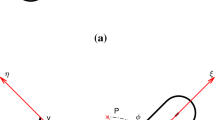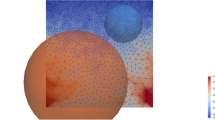Abstract
MMC is one of the topology optimization methods that provides explicit boundary description of the optimized topology. However, due to the inherent nature of MMC, the obtained geometry could exhibit distinct local singularities. To cope with this issue, a non-parametric geometry patching technique for MMC is developed. A moving node patching technique for both 2D and 3D cases is developed in conjunction with MMC to obtain structures with smooth boundaries. Numerical examples in 2D and 3D are presented to demonstrate the effectiveness of the proposed approach.






















Similar content being viewed by others
References
Bai J, Zuo W (2019) Hollow structural design in topology optimization via moving morphable component method. Struct Multidisc Optim 61:187–205
Bendsøe MP (1989) Optimal shape design as a material distribution problem. Struct Optim 1:193–202
Bendsøe MP, Kikuchi N (1988) Generating optimal topologies in structural design using a homogenization method. Comput Methods Appl Mech Engrg 71:197–224
Chang SY, Youn SK (2006) Material cloud method for topology optimization. Int J Numer Methods Eng 65:1585–1607
Chu S, Gao L, Xiao M, Li H (2019) Design of sandwich panels with truss cores using explicit topology optimization. Compos Struct 210:892–905
Guo X, Cheng GD (2010) Recent development in structural design and optimization. Acta Mech Sinica 26:807–823
Guo X, Zhang WS, Zhong WL (2014) Doing topology optimization explicitly and geometrically—a new moving morphable components based framework. J Appl Mech 81:081009
Hoang VN, Jang GW (2017) Topology optimization using moving morphable bars for versatile thickness control. Comput Methods Appl Mech Engrg 317:153–173
Hsu MH, Hsu YL (2005) Interpreting three-dimensional structural topology optimization results. Comput Struct 83:327–337
Hsu YL, Hsu MS, Chen CT (2001) Interpreting results from topology optimization using density contours. Comput Struct 79:1049–1058
Huang XD, Xie YM (2010) Evolutionary topology optimization of continuum structures: Methods and applications. Wiley, Chichester
Kumar AV, Gossard DC (1996) Synthesis of optimal shape and topology of structures. J Mech Des 118:68–74
Liu S, Li Q, Liu J, Chen W, Zhang Y (2018) A Realization method for transforming a topology optimization design into additive manufacturing structures. Engineering 4:277–285
Liu Z, Zhang Y, Huang XM, Li J, Wang D, Wang MQ, Huang X (2020) Development and performance optimization of a parallel computing infrastructure for an unstructured-meshmodelling framework. Geosci Model Dev 2020:1–32
Nishio Y, Liu Y, Ono N (2022) Boundary shape identification method for density based topology optimization. Trans. JSME 88:914–932
Olhoff N, Rasmussen SH (1977) On single and bimodal optimum buckling loads of clamped columns. Int J Solids Struct 13:605–614
Prager W, Rozvany GIN (1977) Optimal layout of grillages. J Struc Mech 5:1–18
Sun J, Tian Q, Hu H, Pedersen N (2018) Topology optimization of a flexible multibody system with variable-length bodies described by ALE–ANCF. Nonlinear Dyn 93:413–441
Wang C, Zhao Z, Zhou M, Sigmund O, Zhang XS (2021) A comprehensive review of educational articles on structural and multidisciplinary optimization. Struct Multidisc Optim 64:2827–2880
Wein F, Dunning PD, Norato JA (2020) A review on feature-mapping methods for structural optimization. Struct Multidisc Optim 62:1597–1638
Wu XC, Shen HP, Zhang TY, Li HY, Liu BG, Yan SD (2023) Research on a boundary regularization geometric reconstruction method of topology optimization structure based on the Freeman code. Adv Mech Eng 15:1–3
Xie YM, Steven GP (1993) A simple evolutionary procedure for structural optimization. Comput Struct 49:885–896
Yi G, Kim NH (2017) Identifying boundaries of topology optimization results using basic parametric features. Struct Multidisc Optim 55:1641
Zhang S, Norato JA, Gain AL, Lyu N (2016a) A geometry projection method for the topology optimization of plate structures. Struct Multidisc Optim 54:1173–1190
Zhang WS, Yuan J, Zhang J, Guo X (2016b) A new topology optimization approach based on moving morphable components (MMC) and the ersatz material model. Struct Multidisc Optim 53:1243–1260
Zhang WS, Wang Y, Du ZL, Liu C, Youn SK, Guo X (2023) Machine-learning assisted topology optimization for architectural design with artistic flavor. Comput Methods Appl Mech Engrg 413:116041
Zheng S, Fan H, Zhang Z, Tian Z, Jia K (2021) Accurate and real-time structural topology prediction driven by deep learning under moving morphable component-based framework. Appl Math Model 97:522–535
Zhou M, Rozvany GIN (1991) The COC algorithm, part II: topological, geometrical and generalized shape optimization. Comput Methods Appl Mech Engrg 89:309–336
Zhu B, Chen Q, Wang R, Zhang X (2018) Structural topology optimization using a moving morphable component-based method considering geometrical nonlinearity. J Mech Des 140(081):403
Zhuang ZC, Xie YM, Zhou SW (2021) A reaction diffusion-based level set method using body-fitted mesh for structural topology optimization. Comput Methods Appl Mech Engrg 381:113829
Zhuang ZC, Xie YM, Li Q, Zhou SW (2022a) Body-fitted bi-directional evolutionary structural optimization using nonlinear diffusion regularization. Comput Methods Appl Mech Engrg 396:115114
Zhuang ZC, Xie YM, Li Q, Zhou SW (2022b) A 172-line matlab code for structural topology optimization in the body-fitted mesh. Struct Multidisc Optim 66:11
Acknowledgements
The financial support from the Foundation for Innovative Research Groups of the National Natural Science Foundation (11821202), the National Natural Science Foundation (12272075), Liao Ning Revitalization Talents Program (XLYC2001003, XLYC1907119), Fundamental Research Funds for the Central Universities (DUT22QN238), Program for Changjiang Scholars, Innovative Research Team in University (PCSIRT), and 111 Project (B14013) are gratefully acknowledged.
Funding
The National Natural Science Foundation, 12272075 and the Foundation for Innovative Research Groups of the National Natural Science Foundation, 11821202.
Author information
Authors and Affiliations
Contributions
WSZ proposed the idea and wrote the main manuscript text. SQZ contributed to coding. SKY improved the manuscript. XG improved the manuscript. All authors reviewed the manuscript.
Corresponding author
Ethics declarations
Conflict of interest
The authors declared no potential conflicts of interest with respect to the research, authorship, and/or publication of this article.
Ethical approval
This article does not contain any studies with human participants or animals performed by any of the authors.
Informed consent
Informed consent was obtained from all individual participants included in the study.
Replication of results
The presented results are produced by subroutines using our in-house code Moving Morphable Component-based topology optimization. The code and data for producing the presented results will be made available by request.
Additional information
Responsible Editor by Kai James.
Publisher's Note
Springer Nature remains neutral with regard to jurisdictional claims in published maps and institutional affiliations.
Rights and permissions
Springer Nature or its licensor (e.g. a society or other partner) holds exclusive rights to this article under a publishing agreement with the author(s) or other rightsholder(s); author self-archiving of the accepted manuscript version of this article is solely governed by the terms of such publishing agreement and applicable law.
About this article
Cite this article
Zhang, W., Zhang, S., Youn, SK. et al. Non-parametric geometry patching technique for MMC topology optimization. Struct Multidisc Optim 67, 77 (2024). https://doi.org/10.1007/s00158-024-03789-9
Received:
Revised:
Accepted:
Published:
DOI: https://doi.org/10.1007/s00158-024-03789-9




